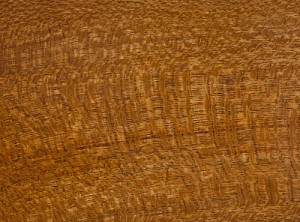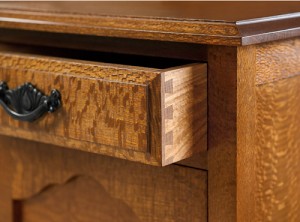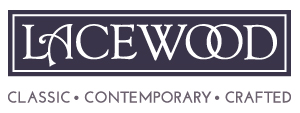Silky Oak
 Silky Oak is a medium density hardwood from far North Queensland and is often referred to as ʻLacewoodʼ in the USA. Northern Silky Oak (Cardwellia Sublimis) is often confused with Southern Silky Oak (Grevillia Robusta) from South East QLD. While they do have similarities, Northern Silky Oak is considered the timber of choice for use in fine furniture applications and we only use the Northern variety in our pieces.
Silky Oak is a medium density hardwood from far North Queensland and is often referred to as ʻLacewoodʼ in the USA. Northern Silky Oak (Cardwellia Sublimis) is often confused with Southern Silky Oak (Grevillia Robusta) from South East QLD. While they do have similarities, Northern Silky Oak is considered the timber of choice for use in fine furniture applications and we only use the Northern variety in our pieces.
Depending on the cut, Silky Oak has textures ranging from fine to medium & coarse. Its natural colour can vary from pale to medium brown, with some pink toning.
History & Uses
Resistant to wood rot, Northern Silky Oak was once used extensively in Queensland for house framing, cladding, external window frames and boat building. In recent times, better management of this resource and restricted felling, means Northern Silky Oak is now used almost exclusively in fine furniture and cabinetry.
Silky Oak has been a long and well-known tradition in the manufacture of furniture and was particularly favoured by many of the early 20th century cabinetmakers in South East Queensland. It can be seen in the fine works of Ed Rosenstengal, Harvey Bros and John Hicks. For over 20 years I have been committed to continuing the tradition of uncompromising quality with the Edwardian Silky Oak pieces in our Classic collection.
Although not as easy to source as it used to be, Silky Oak still enjoys a solid place in the design of furniture, particularly in our reproductions of early 20th century styles.
 Features
Features
Without doubt, the outstanding feature of Silky Oak is its decorative quartersawn figured grain. When quarter sawn, the orientation of the medullary rays offers a glorious palette of beautifully figured ribbons and textured patterns. The availability of quality quartersawn Silky Oak is now limited to very small quantities, so we take the time to selectively (& passionately) use it as feature accents.
The deep lustrous nature of the figured sections is further enhanced with many fine coats of Shellac used in the finishing process. For those who are fond of decorative figured timbers, it’s hard to go past Silky Oak.
.
